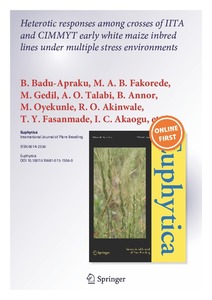| dc.contributor.author | Badu-Apraku, B. |
| dc.contributor.author | Fakorede, M.A.B. |
| dc.contributor.author | Gedil, M. |
| dc.contributor.author | Talabi, A.O. |
| dc.contributor.author | Annor, B. |
| dc.contributor.author | Oyekunle, M. |
| dc.contributor.author | Akinwale, R. |
| dc.contributor.author | Fasanmade, Y. |
| dc.contributor.author | Akaogu, I.C. |
| dc.contributor.author | Aderounmu, M. |
| dc.date.accessioned | 2019-12-04T10:58:11Z |
| dc.date.available | 2019-12-04T10:58:11Z |
| dc.date.issued | 2015 |
| dc.identifier.citation | Badu-Apraku, B., Fakorede, M.A.B., Gedil, M., Talabi, A.O., Annor, B., Oyekunle, M., ... & Aderounmu, M. (2015). Heterotic responses among crosses of IITA and CIMMYT early white maize inbred lines under multiple stress environments. Euphytica, 206(1), 245-262. |
| dc.identifier.issn | 0014-2336 |
| dc.identifier.uri | https://hdl.handle.net/20.500.12478/936 |
| dc.description | Published online: 03 July 2015 |
| dc.description.abstract | Two major constraintsmilitatingagainst the
achievement of food security in West Africa (WA) are
recurrent drought and poor soil fertility. Seventeen early
maturing maize inbreds from IITA and CIMMYT were
used as parents to produce 136 diallel crosses which
were evaluated along with four checks in contrasting
environments atfour locations for 2 year in Nigeria. The
objectives of the study were to (i) examine the combin-
ing ability of the lines under drought, low soil nitrogen
(low N), optimal and across environments; (ii) classify
the inbreds into heterotic groups using the specific
combining ability (SCA) effects of grain yield, heterotic
group’s specific and general combining ability
(HSGCA), the heterotic grouping based on general
combining ability (GCA) of multiple traits (HGCAMT)
and the molecular-based genetic distance methods; (iii)
compare the efficiencies of the four heterotic grouping
methods in classifying the inbreds and identifying the
best testers; and (iv) examine the performance of the
inbreds in hybrid combinations across environments.
Sum of squares for GCA of inbreds for grain yield and
other measured traits were larger than those of the SCA
in all environments. The relative importance of GCA to
SCA effects for grain yield and other traits increased
from stress to nonstress environments with the additive
genetic effects accounting for the major portion of the
total genetic variation under all research environments.
The HSGCA method classified the lines into three
groups and was the most efficient because it had the
highest breeding efficiency (40 %) in the test environ-
ments followed by the HGCAMT, SNP marker-based
and the SCA effectsofgrain yieldmethods. Inbred TZEI
19 was identified as the best tester across research
environments based on HSGCA method. Hybrids ENT
11
9
TZEI 19 and TZEI 1
9
TZEI 19 were the most
outstanding and should be tested extensively in on-farm
trials and commercialized. |
| dc.language.iso | en |
| dc.subject | Zea Mays |
| dc.subject | Drought Tolerance |
| dc.subject | Inbred Lines |
| dc.title | Heterotic responses among crosses of IITA and CIMMYT early white maize inbred lines under multiple stress environments |
| dc.type | Journal Article |
| dc.description.version | Peer Review |
| cg.contributor.crp | Maize |
| cg.contributor.affiliation | International Institute of Tropical Agriculture |
| cg.contributor.affiliation | Obafemi Awolowo University |
| cg.contributor.affiliation | Institute for Agricultural Research, Zaria |
| cg.coverage.region | Africa |
| cg.coverage.region | West Africa |
| cg.coverage.country | Nigeria |
| cg.isijournal | ISI Journal |
| cg.authorship.types | CGIAR and developing countries institute |
| cg.iitasubject | Maize |
| cg.iitasubject | Food Security |
| cg.journal | Euphytica |
| cg.howpublished | Formally Published |
| cg.accessibilitystatus | Limited Access |
| local.dspaceid | 76435 |
| cg.identifier.doi | https://dx.doi.org/10.1007/s10681-015-1506-0 |

